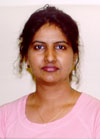College of Graduate Studies student abstract
So the university community can learn more about research College of Graduate Studies students conduct in their pursuit of an MUSC degree, The Catalyst publishes their dissertation abstracts in this column. Each published abstract represents a successful defense of a student's research as judged by the college faculty.Dissertation title: A Novel Role for Lactosylceramide in Inducible Nitric Oxide Synthase Gene Expression and Astrogliosis in Spinal Cord Injury Induced Inflammatory Disease. Investigation of Potential Anit-Inflammatory Interventions in Spinal Cord Injury.
 PhD
candidate: Ravinder Pannu MCBP program.
PhD
candidate: Ravinder Pannu MCBP program.
Successfully defended on Aug. 11. Mentor: Interjit Singh, Ph.D., professor, Department of Pediatrics
Spinal cord injury (SCI) is a relatively new field of research because the age-old dogma that the spinal cord could not be repaired after damage was only recently refuted. However, at present there is no universally accepted treatment for SCI-induced disability.
Damage to the spinal cord does not stop with the initial (primary) injury, but continues in the hours following trauma causing secondary neuronal damage. Immune reactions worsen the impact of the primary injury and cause greater neuronal loss, thus generating secondary damage and causing further functional decline.
Secondary injury also damages myelin, the insulation that protects nerves when they are intact. Recent studies have shown that the damaged myelin actually has chemical inhibitors that can stop nerve cells from regenerating their axons. These sources of secondary damage interact in complex ways that scientists are just beginning to understand.
Research done during my doctoral studies under the able mentorship of Dr. Singh was aimed at evaluating drugs or other interventions that protect against secondary neuronal injury as well as provide insight into the mechanisms causing such damage. This work resulted in the identification of a novel bioactive lipid, Lactosylceramide (LacCer) that was found elevated and critical in mediating inflammatory reactions, neuronal death, and loss of myelin post-SCI. Treatment with a pharmacological agent that inhibits the synthesis of LacCer showed significantly reduced paralysis following SCI when tested in rats.
Rats treated with this inhibitor regained greater locomotor function as compared to the untreated rats which remain substantially paralyzed for weeks post-SCI. Furthermore, in the quest for anti-inflammatory therapeutics, the efficacy of statins (commonly prescribed cholesterol lowering drugs) was also tested. Research conducted in our laboratory and by other groups has demonstrated anti-inflammatory action of statins in neurodegenerative disorders such as multiple sclerosis. When tested in a rat model of SCI, statin treatment resulted in near normal recovery of locomotor function post-trauma. We determined the mechanism of action to be through decreased secondary injury. However, much more remains to be understood as far as the mechanism of action of the two anti-inflammatory drugs we have tested.
Through these studies we have identified two approaches which can limit secondary damage to the spinal cord following trauma. This is particularly significant since minimizing the damage to the spinal cord in response to the primary injury also limits the extent of long-term disability thus giving the central nervous system (CNS) a chance to regenerate and recover.
It had long been believed that our adult mammalian CNS does not regenerate after damage due to injuries or degenerative diseases. Today, however, the CNS has come to be recognized as an important target of so called “regenerative medicine.”This research demonstrated the therapeutic advantage of suppressing post-SCI inflammation. The treatment not only limits the extent of secondary damage but creates an environment conducive to recovery. Future challenges entail studying regenerative mechanisms and identifying agents that would promote/support axonal sprouting and myelination which would eventually reverse the paralysis caused by SCI.
Future plans: Immediate Future plans: Gaining post-doctoral experience
in the laboratory of Dr. Singh until August 2005. I will be studying regeneration
and demyelination mechanisms in spinal cord injury. I also plan to dabble
in some teaching while at MUSC. Long-term plans: A research-oriented
career with some teaching.
Friday, Oct. 15, 2004
Catalyst Online is published weekly, updated
as needed and improved from time to time by the MUSC Office of Public Relations
for the faculty, employees and students of the Medical University of South
Carolina. Catalyst Online editor, Kim Draughn, can be reached at 792-4107
or by email, catalyst@musc.edu. Editorial copy can be submitted to Catalyst
Online and to The Catalyst in print by fax, 792-6723, or by email to petersnd@musc.edu
or catalyst@musc.edu. To place an ad in The Catalyst hardcopy, call Community
Press at 849-1778.